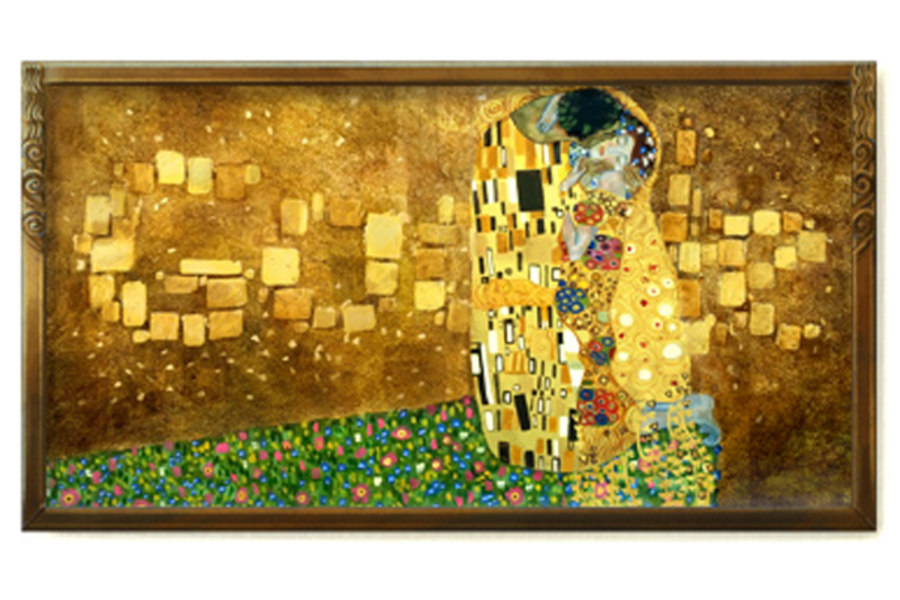Gustav Klimt: Why some say 'The Kiss' is better than the 'Mona Lisa'
Loading...
When Google decided to honor painter Gustav Klimt with a Google Doodle, choosing the right image probably didn't take too long.
The company most likely wanted to show something from his "Golden Period," a time when Klimt lavished his work with gold leaf. The team couldn't pick one of his many nude images (many in the early 1900s described his work as "pornography"). Plus, the Google Doodle crew probably wanted to display his best work, like, say, a painting that some believe to be better than the "Mona Lisa."
So, the search engine replaced its regular logo with an homage to Klimt's "The Kiss."
The painting shows a couple embracing. While we see their faces, most of their bodies hide behind gilded ropes. Gold douses the background, too, creating a glimmering fog around the pair – as if, in this moment, they were the only things left in this world.
What about "The Kiss" makes it so special? The golden painting is certainly less recognizable than the "Mona Lisa," a painting that is a top contender for the world's most famous piece of art. Critics praise the "Mona Lisa" for its technique, atmosphere, composition, and mysterious smile.
That said, the Mona Lisa might be better experienced in a book than in real life. The actual painting is rather small – and appears smaller still considering the crowd that always surrounds it. If you want to examine the brushstrokes and appreciate the artistry, you'd best look for a print.
"Unlike the Mona Lisa, which disappoints when you confront it... 'The Kiss' by Gustav Klimt surpasses expectations," writes journalist Adrian Brijbassi. "For one thing, it’s not nearly as celebrated a painting, so public fascination isn’t high to begin with. More importantly, though, it does what a great piece of art is supposed to do: Hold your gaze, make you admire its aesthetic qualities while trying to discern what’s beyond its superficial aspects."
Canadian artist Charles Moffat backs up this first impression. He says that "The Kiss" is "widely considered to be the greatest painting ever, better than even the Mona Lisa."
Klimt never kept a journal and rarely wrote about his own work. Because of this, people need to interpret the work for themselves. Alfred Weidinger, curator of the Belvedere Palace Museum in Vienna, Austria, where "The Kiss" resides, imagines that the scene shows two lovers sitting beside a lake. The early morning light shines on the water, creating the golden gleam that dominates the painting.
The ropes signify the love between the couple. It's hard to tell where one person stops and the other begins. In this moment, they are one.
Just as the "Mona Lisa" has an enigmatic smile, "The Kiss" has its own curious expression. It's hard to tell if the woman welcomes the embrace. She almost seems asleep, perhaps dreaming of a perfect love and a golden wardrobe.
"The Kiss" also mixes together a very modern style with aspects of older art, such as myths (the floral crown atop the man), religious artwork (particularly Christian icons), and the more contemporary Arts and Crafts movement.
Not everyone agrees on the importance of this painting, nor of Klimt's legacy. He is undeniably popular – in 2006, Klimt's portrait "Adele Bloch-Bauer I" sold for $135 million, the highest price ever reported on a painting. (Last year, a piece by Paul Cezanne broke the record with a $250 million bid.) But popularity doesn't mean that you influence other artists.
"Klimt, of course, is an important artist – he's a very popular artist – but in terms of the history of art, he's a very unimportant artist," said writer Frank Whitford in a BBC special about "The Kiss," according to a transcript. "Although he sums up so much in his work, about the society in which he found himself – in art historical terms his effect was negligible. So he's an artist really in a cul-de-sac."
What do you think about "The Kiss"? How do you interpret the scene? Let us know in the comments below.
For more on how technology intersects daily life, follow Chris on Twitter @venturenaut.








